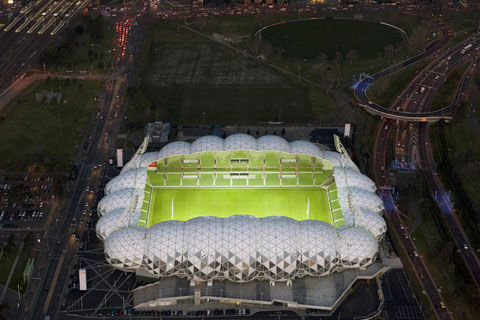Chepauk Stadium, Stage One - Entered in the LSAA 2011 Design Awards (Cat 4)
This project was ambitious from the beginning; a large scale elevated cover over three grandstand seating structures presented a few structural challenges.
The purpose as with many tensile membrane projects was a combination of shade and weather cover. Each seating section required these basic needs met while maintaining a uniform style and aesthetic appeal through out. Our client, The Tamil Nadu Cricket Association, requested minimal connections to the supporting grandstand structure, leaving more space beneath for spectator seating.
The project was designed to create a unique feature to the venue. Often large scale tension membrane roofing contribute a large amount to the look and feel of a venue, it’s a prominent feature and one that needs to be eye-catching and unique.
The complexities involved in the project began at the design phase. Our client requested only two main footings for each stand cover. This translated to a massive 28m span between each supporting column. Cable truss systems were designed to strengthen these uprights that supported 4 large cones.
The project met all design and connection criteria set out by our client while providing a unique aesthetic appeal. The engineering involved on making this shape work was a challenge both in the planning stages and installation.
Our client was suitably impressed with the final product, so much that after stage one was complete consisting of 3 such structures (12 cones) another 6 stadia cover were commissioned for the same venue. Now complete the venue has 9 spectator stands covered all with a continuous design and aesthetic appeal.
DESIGN / FABRICATION / INSTALLATION BRIEF
The brief was to provide a lightweight roof for the cricket ground with a minimalist steel support structure. The project was given a very short lead time to meet major cricket events. This short time frame also meant prefabricated building components were used and adjustability to allow for supporting grandstand construction tolerances.
STRUCTURAL SYSTEMS
The structural system consists of major steel columns from which steel beams and cables are supported. Cable tie systems suspend critical steel elements and pull up point for the membrane. The entire structure allows for adjustment in the structural system in order to accommodate construction tolerances in India.
MATERIALS
Local steel was used along with local steel fabrication. Cables were sourced from China and imported into India in order to minimize delivery time for the tight schedule. Membrane was Sheerfill 2 and was selected for durability and strength under high wind loads.
FABRICATION
Prior to patterning a biaxial stretch test was performed on the batch of fabric used on this project. By analyzing the data retrieved from the fabric’s reaction to tension along both the weft and warp of the weave MakMax engineers were able to design the shape of each panel ensuring optimal tension and strength within each panel. Without this process and the data it produced there is no guarantee that each panel is being accurately patterned to suit the fabrics tensile parameters. The process of testing tensile strength in fabric in house at MakMax is part of the ISO 14001 Quality certification.
Due to the tight time frame and large panel areas fabrication of the PTFE membrane took place at the Japanese arm of the global business, Taiyo Kogyo Corporation.
COLLABORATION, CONSTRUCTION AND MAINTENANCE
The structure was a collaboration between architects in Great Britain, engineers in Australia along with the client, installers, and fabricators in India. The membrane schedule calls for yearly inspections by local authorities as well as yearly cleaning of the membrane surface.
CREDITS
Project Number: 4003
Title: Chepauk Stadium, Stage One
Location: Tamil Nadu Cricket Ground, Chennai, India
Entrant: MakMax
Role: Design, fabrication and installation
Client: The Tamil Nadu Cricket Association
Architect: Nataraj Venkat & Associates
Structural Engineer: Sterling Engineering Consultancy Services






